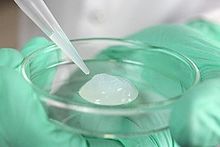Hydrogel from wood-based nanofibrillated cellulose (NFC) is used as a matrix for 3D cell culture, providing a three-dimensional environment that more closely resembles the conditions found in living tissue. As plant based material, it does not contain any human- or animal-derived components. Nanocellulose is instead derived from wood pulp that has been processed to create extremely small, nanoscale fibers. These fibers can be used to create a hydrogel, which is a type of material that is made up of a network of cross-linked polymer chains and is able to hold large amounts of water.[1]

Overview
editAs the natural extracellular matrix (ECM) is important in the survival, proliferation, differentiation and migration of the cells, hydrogels mimicking natural ECM structure are considered as potential approaches towards in vivo –like cell culturing.[2][3] GrowDex is NFC hydrogel for 3D cell culture commercialized by UPM, Finland.[4]
Material properties
editNFC fiber network structure and dimensions in hydrogel resemble human ECM.[5] Stiffness can be tuned to optimize the conditions for each cell type. Shear-thinning property of the material makes the gel ready to use without cross-linking or gelification step. The nanocellulose hydrogel can be completely degraded by cellulase enzyme treatment while retaining the 3D cell structures.[4][6]
Applications
editNFC hydrogel in 3D cell culture offers a platform for various biomedical applications.[7] Different cell lines and cell types have been cultured in NFC, including e.g. differentiation of human hepatic cells to functional organotypic cultures,[8] and proliferation of human pluripotent stem cells.[4] Organotypic liver cell cultures can be used in drug discovery for testing liver toxicity and metabolism of the novel drug candidates. The possibility to use the hydrogel with robotic dispensers enables its use in high throughput screening (HTS) formats.[9]
Additionally, 3D cell culture using wood-based nanocellulose hydrogel can be used for tissue engineering.[10]
References
edit- ^ Ahmed, Enas M. (2015-03-01). "Hydrogel: Preparation, characterization, and applications: A review". Journal of Advanced Research. 6 (2): 105–121. doi:10.1016/j.jare.2013.07.006. ISSN 2090-1232. PMC 4348459. PMID 25750745.
- ^ Tibbitt, Mark W.; Anseth, Kristi S. (2009). "Hydrogels as extracellular matrix mimics for 3D cell culture". Biotechnology and Bioengineering. 103 (4): 655–63. doi:10.1002/bit.22361. PMC 2997742. PMID 19472329.
- ^ Geckil, Hikmet; Xu, Feng; Zhang, Xiaohui; Moon, SangJun; Demirci, Utkan (2010). "Engineering hydrogels as extracellular matrix mimics". Nanomedicine. 5 (3): 469–84. doi:10.2217/nnm.10.12. PMC 2892416. PMID 20394538.
- ^ a b c Lou, Yan-Ru; Kanninen, Liisa; Kuisma, Tytti; Niklander, Johanna; Noon, Luke A.; Burks, Deborah; Urtti, Arto; Yliperttula, Marjo (2014). "The Use of Nanofibrillar Cellulose Hydrogel As a Flexible Three-Dimensional Model to Culture Human Pluripotent Stem Cells". Stem Cells and Development. 23 (4): 380–92. doi:10.1089/scd.2013.0314. PMC 3920753. PMID 24188453.
- ^ Bhattacharya, Madhushree; Malinen, Melina M.; Lauren, Patrick; Lou, Yan-Ru; Kuisma, Saara W.; Kanninen, Liisa; Lille, Martina; Corlu, Anne; GuGuen-Guillouzo, Christiane; Ikkala, Olli; Laukkanen, Antti; Urtti, Arto; Yliperttula, Marjo (2012). "Nanofibrillar cellulose hydrogel promotes three-dimensional liver cell culture". Journal of Controlled Release. 164 (3): 291–8. doi:10.1016/j.jconrel.2012.06.039. PMID 22776290.
- ^ Ahola, S.; Turon, X.; Österberg, M.; Laine, J.; Rojas, O. J. (2008). "Enzymatic Hydrolysis of Native Cellulose Nanofibrils and Other Cellulose Model Films: Effect of Surface Structure". Langmuir. 24 (20): 11592–9. doi:10.1021/la801550j. PMID 18778090.
- ^ Lin, Ning; Dufresne, Alain (2014). "Nanocellulose in biomedicine: Current status and future prospect". European Polymer Journal. 59: 302–25. doi:10.1016/j.eurpolymj.2014.07.025. INIST 28828554.
- ^ Malinen, Melina M.; Kanninen, Liisa K.; Corlu, Anne; Isoniemi, Helena M.; Lou, Yan-Ru; Yliperttula, Marjo L.; Urtti, Arto O. (2014). "Differentiation of liver progenitor cell line to functional organotypic cultures in 3D nanofibrillar cellulose and hyaluronan-gelatin hydrogels". Biomaterials. 35 (19): 5110–21. doi:10.1016/j.biomaterials.2014.03.020. PMID 24698520.
- ^ Robotic dispensing of NFC hydrogel
- ^ Athukoralalage, Sandya S.; Balu, Rajkamal; Dutta, Naba K.; Roy Choudhury, Namita (May 2019). "3D Bioprinted Nanocellulose-Based Hydrogels for Tissue Engineering Applications: A Brief Review". Polymers. 11 (5): 898. doi:10.3390/polym11050898. ISSN 2073-4360. PMC 6572377.